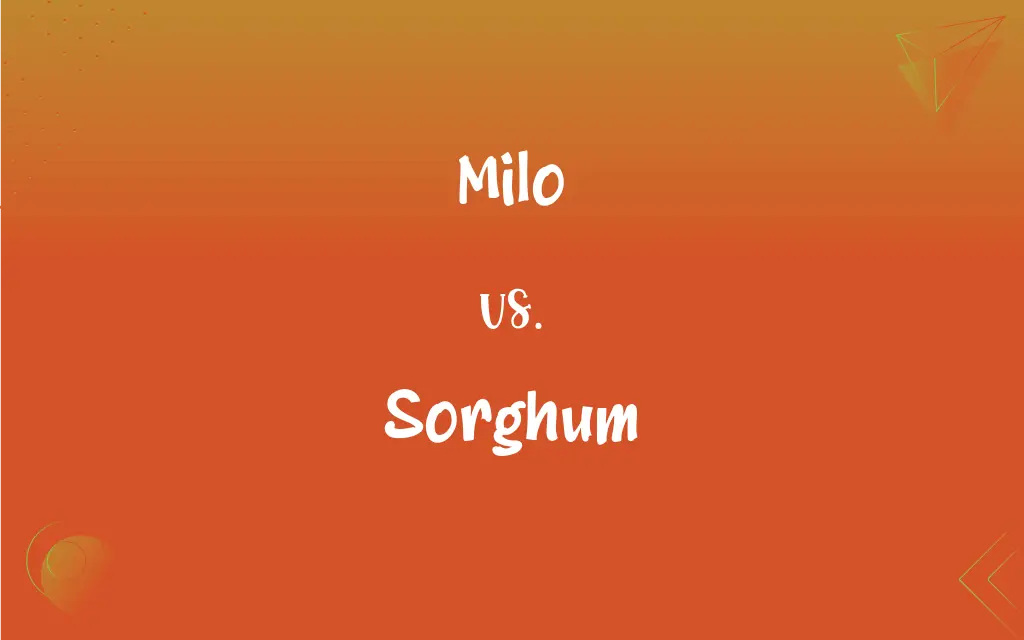Milo vs. Sorghum: What's the Difference?
By Aimie Carlson & Janet White || Updated on March 4, 2024
Milo is a type of sorghum, specifically grown for grain, while sorghum encompasses a wider range of species, including those for grain, syrup, and fodder.

Key Differences
Milo, often referred to as grain sorghum, is a cereal grain that belongs to the broader sorghum family. It is primarily cultivated for its grain, which is used in food products for humans and feed for livestock. Milo is characterized by its resistance to drought and heat, making it a popular crop in arid and semi-arid regions. On the other hand, sorghum refers to a genus of plants that includes multiple species, some of which are grown for grain (like milo), while others are cultivated for syrup production or as fodder for animals.
Sorghum, as a genus, includes varieties that are used for different purposes based on their end-use. For instance, sweet sorghums are grown for their stalks, which are processed to produce sorghum syrup, a sweetener. Conversely, milo specifically refers to the grain-producing varieties of sorghum that are harvested for their seeds. This distinction is crucial for agricultural and culinary purposes, as the various types of sorghum serve different needs.
The cultivation practices for milo versus other types of sorghum can vary depending on the intended use of the crop. Milo, being a grain sorghum, is typically grown in conditions that favor the development of seeds. It requires management practices aimed at maximizing grain yield. Whereas, sweet sorghum, grown for syrup, or forage sorghum, grown for biomass, might be selected for different traits such as stalk volume or sugar content, leading to different cultivation and harvesting techniques.
Nutritionally, milo (grain sorghum) offers benefits similar to other cereal grains, including being a good source of carbohydrates and dietary fiber. It is also gluten-free, making it a suitable grain option for those with gluten sensitivities or celiac disease. The nutritional content of sorghum varies among the different types, with sweet sorghum being valued for its sugar content and forage sorghum for its biomass used in animal feed.
Both milo and other forms of sorghum have seen increased interest in recent years due to their adaptability to harsh growing conditions and their potential as sustainable crops. They play a significant role in food security and are being researched for their potential in biofuel production, highlighting their importance beyond traditional agricultural uses.
ADVERTISEMENT
Comparison Chart
Purpose
Grown for grain
Grown for grain, syrup, or fodder
Use
Human food, livestock feed
Human food, livestock feed, sweetener, biomass
Cultivation
Focused on grain yield
Varied, based on desired product (grain, syrup, biomass)
Nutritional Content
High in carbohydrates, dietary fiber, gluten-free
Varies; sugar content in sweet sorghum, biomass in forage sorghum
Adaptability
Drought and heat resistant
Generally drought and heat resistant, with variations among types
ADVERTISEMENT
Milo and Sorghum Definitions
Milo
A cereal grain used for food and feed.
Farmers in the region primarily grow milo due to its drought tolerance.
Sorghum
Sweet sorghum for syrup.
Sweet sorghum stalks are processed to make a natural sweetener.
Milo
Livestock feed.
The harvested milo will be used to feed cattle through the winter.
Sorghum
Forage sorghum for animal feed.
Forage sorghum is grown specifically for its biomass, ideal for grazing.
Milo
A type of sorghum grown for its grain.
Milo is harvested for its nutrient-rich seeds.
Sorghum
A genus of plants with various uses.
Sorghum varieties can be found in many products, from foods to biofuels.
Milo
A crop resistant to harsh conditions.
Milo thrives here, even in the driest seasons.
Sorghum
Adapted to a variety of climates.
Sorghum's versatility makes it a valuable crop in both temperate and tropical regions.
Milo
Gluten-free grain option.
Milo flour is a great gluten-free alternative for baking.
Sorghum
A cultivated grass (Sorghum bicolor) native to sub-Saharan Africa, several varieties of which are widely grown for their grain, as forage, or as a source of syrup.
Milo
Any of various sorghums that are cultivated for their grain, which resembles millet. Also called grain sorghum.
Sorghum
Syrup made from the juice of this plant.
Milo
(US) sorghum
Sorghum
A cereal, Sorghum genus and species, the grains of which are cultivated to make flour and feed cattle. Almost all cultivated ones as well as some wild ones belong to the species Sorghum bicolor (syn. Sorghum vulgare).
Milo
Small drought-resistant sorghums having large yellow or whitish grains
Sorghum
(Southern US) Sorghum syrup.
Sorghum
A genus of grasses, properly limited to two species, Sorghum Halepense, the Arabian millet, or Johnson grass (see Johnson grass), and S. vulgare, the Indian millet (see Indian millet, under Indian).
Sorghum
Economically important Old World tropical cereal grass
Sorghum
Made from juice of sweet sorghum
Sorghum
Diverse crop for sustainable agriculture.
Sorghum is being researched for its potential in biofuel production.
FAQs
Can sorghum be used in gluten-free diets?
Yes, grain sorghum, including milo, is gluten-free and can be used in diets for those with gluten sensitivities.
What is milo used for?
Milo is primarily used as a grain for human consumption and as feed for livestock.
What distinguishes sweet sorghum from grain sorghum?
Sweet sorghum is grown for its stalks, which are processed into syrup, whereas grain sorghum, like milo, is grown for its seeds.
Are there any health risks associated with consuming sorghum?
Sorghum is generally safe and nutritious to consume, but like any food, it should be eaten in moderation as part of a balanced diet. People with rare allergies to sorghum should avoid it.
How does sorghum contribute to sustainability?
Sorghum is drought and heat-resistant, requiring less water, making it a sustainable crop choice in arid regions and under changing climate conditions.
Can sorghum be used for biofuel?
Yes, sorghum, particularly certain varieties, is being explored as a source for biofuel production due to its efficient biomass conversion.
What are the nutritional benefits of milo?
Milo is high in carbohydrates and dietary fiber, offering a nutritious, gluten-free grain option.
Is milo the same as maize?
No, milo is a type of sorghum, which is distinct from maize (corn), although both are cereal grains used for similar purposes.
Can milo be used in baking?
Yes, milo grain can be ground into flour and used in gluten-free baking recipes as an alternative to wheat flour.
How is forage sorghum different from milo?
Forage sorghum is grown for its biomass, used as animal feed, whereas milo is specifically cultivated for its grain.
Why is milo important in agriculture?
Milo is valued for its adaptability to harsh growing conditions, providing a reliable crop option for food and feed in challenging climates.
What makes sorghum a good choice for animal feed?
Sorghum is nutrient-rich, drought-resistant, and produces a high biomass, making it a cost-effective and sustainable option for animal feed.
How does the processing of milo differ from other grains?
Milo is typically processed into flour, meal, or used whole in various dishes. Its processing might require specific considerations due to its hardness and size compared to other grains.
What environmental benefits does cultivating sorghum provide?
Sorghum improves soil health due to its deep rooting system, requires less water, and can help in crop rotation strategies to manage pests and diseases, contributing to sustainable agriculture practices.
Are there any specific diseases or pests that affect milo or sorghum crops?
Yes, like all crops, milo and sorghum can be susceptible to certain pests and diseases, including sorghum midge, aphids, and fungal diseases like anthracnose, which require careful management and prevention strategies.
What climate conditions are ideal for growing milo?
Milo thrives in hot, dry climates where other cereal grains might not perform well, making it an ideal crop for arid and semi-arid regions.
Is there a difference in yield between milo and sweet sorghum?
Yes, the yield can differ significantly based on the variety, with milo focusing on grain yield and sweet sorghum on the volume of juice from stalks, influenced by cultivation practices and environmental conditions.
How can sorghum be incorporated into a vegetarian or vegan diet?
Sorghum can be used as a primary grain in meals, offering a gluten-free and nutritious base for a variety of dishes suitable for vegetarian and vegan diets.
How is sorghum syrup made from sweet sorghum?
Sorghum syrup is made by extracting juice from the stalks of sweet sorghum and then boiling it down to concentrate the sugars into a syrup.
How does the cultivation of milo and sweet sorghum differ?
Milo cultivation focuses on maximizing grain yield, while sweet sorghum cultivation aims to produce a high volume of sugar-rich stalks for syrup production.
About Author
Written by
Aimie CarlsonAimie Carlson, holding a master's degree in English literature, is a fervent English language enthusiast. She lends her writing talents to Difference Wiki, a prominent website that specializes in comparisons, offering readers insightful analyses that both captivate and inform.
Co-written by
Janet WhiteJanet White has been an esteemed writer and blogger for Difference Wiki. Holding a Master's degree in Science and Medical Journalism from the prestigious Boston University, she has consistently demonstrated her expertise and passion for her field. When she's not immersed in her work, Janet relishes her time exercising, delving into a good book, and cherishing moments with friends and family.
































































